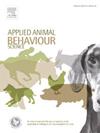Effect of turnout rugs on the behaviour of horses under mild autumn conditions in the United Kingdom
IF 2.2
2区 农林科学
Q1 AGRICULTURE, DAIRY & ANIMAL SCIENCE
引用次数: 0
Abstract
The use of rugs (blankets) for horses is commonplace as a protective measure to keep horses warm and dry in inclement weather, or to protect them from direct sunshine or insects under warmer conditions. However, rugs can also result in thermal or general discomfort, and information on horse responses to rugs is needed to inform owner decisions. The aim of this experimental study was to assess the effect of turnout rugs on the behaviour of horses under relatively benign weather conditions, looking for indications of either positive (protective) or negative (discomfort) effects. Ten healthy horses, accustomed to wearing rugs, were recruited from two sites in southern England, and observed for 30-minute sessions (15–24 sessions/horse, 172 in total). Observations were counterbalanced to allow approximately equal numbers of observations with turnout rugs on and off, each horse experiencing both conditions. Ambient temperature varied from 1 to 15 °C, and windspeed from 6 to 15 mph and no signs of heat or cold stress were observed during the study. Generalised estimating equations (GEE) were used to estimate the parameters of the regression models and to account for correlations between repeated observations on the same individual horses. Significant interactions between Rug status and Location were found for Standing, Grazing, Walking and Tail Swishing. Rug wearing was associated with decreased Walking, Tail swishing, and Grooming Self at both study sites, decreased Head Shaking at one site and increased Grazing at one site. Tail Swishing increased by 1.33 counts for every 1 °C rise in temperature, and decreased by 0.84 counts for every 1mph increase in windspeed Midges (Culicoides spp) were informally observed at both sites and would have been more active at higher temperatures and lower windspeeds. Overall, the turnout rugs appeared to reduce this insect nuisance (as indicated by the reduced tail-swishing and head-shaking). However, the rugs were generally heavier than required for this purpose, and reduced Grooming Self and Walking could indicate restrictions imposed by rug design. In conclusion, when weather conditions are relatively mild (above 5 °C) horse welfare may be improved by the use of lightweight turnout rugs for fly protection.
在英国,在温和的秋季条件下,道场地毯对马行为的影响
在恶劣的天气里,为马使用地毯(毯子)是一种常见的保护措施,可以让马保持温暖和干燥,或者在温暖的条件下保护它们免受阳光直射或昆虫的伤害。然而,地毯也会导致热或全身不适,需要马对地毯的反应信息来告知主人的决定。本实验研究的目的是评估在相对温和的天气条件下,道场地毯对马行为的影响,寻找积极(保护)或消极(不适)影响的迹象。从英格兰南部的两个地点招募了10匹健康的马,习惯于戴地毯,观察30分钟(15-24次 /匹马,总共172次)。观察结果进行了平衡,使每匹马在两种情况下都经历了大约相同数量的观察。环境温度在1到15 °C之间变化,风速在6到15英里/小时之间变化,在研究期间没有观察到热或冷应激的迹象。使用广义估计方程(GEE)来估计回归模型的参数,并解释对同一匹马的重复观察之间的相关性。在站立、放牧、行走和摇尾时,地毯状态与位置之间存在显著的交互作用。在两个研究地点,穿着地毯的人走路、摇尾巴和梳理自己的次数都减少了,一个地点的摇头次数减少了,一个地点的放牧次数增加了。温度每升高1 °C,摇尾次数增加1.33次,风速每增加1英里,摇尾次数减少0.84次,在这两个地点都非正式地观察到蠓(库蠓),它们在更高的温度和更低的风速下会更活跃。总的来说,地毯似乎减少了这种昆虫的滋扰(从减少摇尾巴和摇头可以看出)。然而,地毯通常比这一目的所要求的要重,并且减少了自我梳理和行走可能表明地毯设计施加了限制。综上所述,当天气条件相对温和(高于5 °C)时,马的福利可以通过使用轻质的道场地毯来保护苍蝇而得到改善。
本文章由计算机程序翻译,如有差异,请以英文原文为准。
求助全文
约1分钟内获得全文
求助全文
来源期刊

Applied Animal Behaviour Science
农林科学-行为科学
CiteScore
4.40
自引率
21.70%
发文量
191
审稿时长
18.1 weeks
期刊介绍:
This journal publishes relevant information on the behaviour of domesticated and utilized animals.
Topics covered include:
-Behaviour of farm, zoo and laboratory animals in relation to animal management and welfare
-Behaviour of companion animals in relation to behavioural problems, for example, in relation to the training of dogs for different purposes, in relation to behavioural problems
-Studies of the behaviour of wild animals when these studies are relevant from an applied perspective, for example in relation to wildlife management, pest management or nature conservation
-Methodological studies within relevant fields
The principal subjects are farm, companion and laboratory animals, including, of course, poultry. The journal also deals with the following animal subjects:
-Those involved in any farming system, e.g. deer, rabbits and fur-bearing animals
-Those in ANY form of confinement, e.g. zoos, safari parks and other forms of display
-Feral animals, and any animal species which impinge on farming operations, e.g. as causes of loss or damage
-Species used for hunting, recreation etc. may also be considered as acceptable subjects in some instances
-Laboratory animals, if the material relates to their behavioural requirements
 求助内容:
求助内容: 应助结果提醒方式:
应助结果提醒方式:


